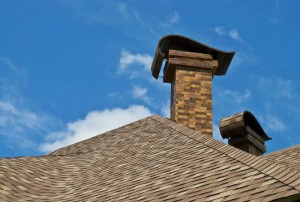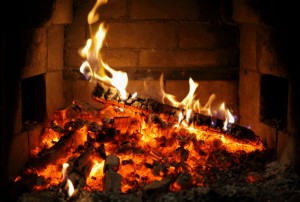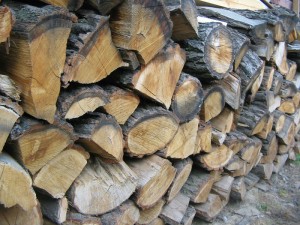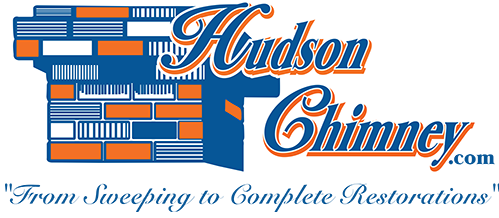by Mark Hudson | Sep 29, 2015 | Chimney Safety Week
Whenever September arrives, Hudson Chimney knows that not only will we be busy preparing chimneys in the Jacksonville, Florida area for the upcoming fireplace season, but we will also be getting ready to celebrate with the Chimney Safety Institute of America (CSIA) during their annual National Chimney Safety Week, which occurs the last week of September (September 27 – October 3, 2015). This is an opportunity for chimney professionals across the country to educate people about fire and chimney safety before the weather starts getting cold. A fireplace and chimney system can present many hazards, so it is important to know and follow safety practices whenever you use this part of your home. The last thing you would want to happen this winter is a devastating chimney fire because you neglected to schedule your annual chimney inspection. The Director of Education for the CSIA, Ashley Eldridge says, “Fires in chimneys can start for a variety of reasons. They can be poorly built, or incorrectly designed, or the chimney flue sees a buildup of creosote over time. If you’ve ignored the need for an inspection, you are taking a risk.” Other than having your chimney professionally inspected every year, the CSIA offers other things you should do to reduce your risk of a chimney fire, and we would like to share them with you.

Your chimney is not the only part that should be inspected.
Your wood-burning or gas fireplace should also be examined by a professional to be sure no potential hazards exist. A wood-burning firebox could also have a large buildup of creosote, and this can be an extremely dangerous situation. Ensure your firebox is free from any creosote accumulation before you light a fire inside it. Gas and propane logs may not produce any soot or creosote, but they can deposit corrosive substances within your chimney. Ceramic logs in gas fireplaces can also deteriorate and clog the vents and pilot light. Having the logs checked in your gas fireplace can prevent chimney fires and other fireplace issues that can happen when the pilot light and other connectors are not correctly working.
Be prepared for all severe weather hazards.
To be sure you are ready for a severe storm, such as a hurricane, the CSIA suggest three steps:
1. Know your risk.
Before leaving home in the morning, check the weather reports to be sure you are prepared for any coming weather event.
2. Take action!
Find out more about what kind of weather your area should expect this fall. Make an emergency supplies kit. Come up with a communication plan for your entire family in case of an emergency.
3. Be a force of nature.
If a hurricane or other severe weather storm is heading your way, spread the word! Inspire your friends and family by letting them know how you have prepared for the potentially bad weather.
If you would like to learn more about National Chimney Safety Week, contact us at Hudson Chimney. We are happy to educate you on fire prevention!
by Mark Hudson | May 28, 2015 | Jacksonville
In 1979, Mark Hudson founded Hudson Chimney to provide professional fireplace and chimney services in Northeastern Florida. Certified by the Chimney Safety Institute of America (CSIA) as a chimney sweep and a dryer vent technician, Hudson is proud to serve the city of Jacksonville and works hard on community projects to make Jacksonville an even better place. We would like to tell you more about this beautiful city we have served for over 30 years.

WATER ACTIVITIES
With over 22 miles of beaches, Jacksonville is home to three beaches: Atlantic Beach, Jacksonville Beach, and Neptune Beach. Our beach areas offer dining, entertainment, lodging, and recreational activities for the entire family. Fishermen have the best of both worlds in Jacksonville with freshwater and saltwater fishing opportunities. You can even deep sea fish in the Atlantic Ocean. The St. Johns River flows through the city and provides a place to kayak and paddleboard.
ARTS AND CULTURE
Named as one of the top 25 destinations for the arts in this country, Jacksonville is home to several museum, including the Museum of Contemporary Art Jacksonville (MOCA). At MOCA, you will find over one thousand works of art, such as painting, photography, sculpture, and printmaking. You can also find live theater and live music throughout the city as well as festivals throughout the year that celebrate jazz, blues, and country music.
SPORTS
Sports fans have a lot to enjoy in Jacksonville. You can watch professional football by going to see a Jacksonville Jaguars game, and you can catch one of the biggest professional golf tournaments, THE PLAYERS Championship. Golfers can even play a round at the site of this tournament. Outdoor sports enthusiasts can enjoy biking, hiking, canoeing, surfing, and other activities along our scenic waterways.
HISTORY
Filled with multiculturalism, the history of Jacksonville can be found throughout the city. One of the city’s most important historical sites is Fort Mose, which was both the earliest legal settlements in America for free Africans and the precursor site to the Underground Railroad. For a deeper look at the history of Jacksonville, tour one of our historical museums, such as the Mandarin Museum & Historical Society that shows what life was like in 19th century Florida.
SHOPPING
Whether you prefer shopping at a mall, at locally-owned boutiques, along the beachside, or in a downtown setting, Jacksonville is filled with opportunities to shop until you drop. If you like to save money, you will enjoy shopping at our two outlet shopping centers. No matter your budget, shopping enthusiasts will love what our city has to offer.
Want to know more about Jacksonville? Contact Hudson Chimney to find out our favorite places and things to do in this beautiful city.
by Mark Hudson | Dec 24, 2014 | Ash Disposal
Every time you have a wood or pellet-fueled fire, it is a fact of life that ashes will be left behind for you to remove. Do you know how to properly dispose of these ashes? If not, you could end up with a fire caused by the hot coals hidden within the ashes. At Hudson Chimney, we place a high priority on chimney and fireplace safety, so we thought we would share with you some answers to questions on how to correctly remove ashes to protect you from the possibility of a fire.

How Does Improper Ash Removal Lead to a Fire?
Many times, homeowners think that simply storing ashes in a metal bucket with no lid is the proper way to remove ashes. However, this is not the case. When this unlidded bucket is sitting outside on your porch, winds can easily blow the bucket over, and this can cause all of the ashes to fall out onto your porch or yard. When this occurs, the ashes get stirred up, and the hot coals become active once again. If your porch has a wooden floor, you could have a dangerous porch fire on your hands caused by the incorrect way of removing and storing ashes. You may also end up with an uncontrollable brushfire in your yard.
What Is the Best Container for Storing Ashes?
The importance of using a proper ash container cannot be stressed enough. Hudson Chimney strongly recommends using a pail or bucket made of sheet metal with a securely fitted lid. The most essential key for safety is the lid. To be even safer, the bottom of the pail should be slightly offset so that the actual bottom does not make contact with flooring and char the surface.
Where Is the Best Place to Store My Ash Bucket?
Never place your bucket on a wooden floor as this can be a fire hazard, even if the bucket has an elevated bottom. You should always store your ash bucket outside on a non-combustible surface such as stone, brick, concrete, or slate.
Is it Necessary to Remove Ashes After Every Fire?
According to the Chimney Safety Institute of America (CSIA), you do not have to remove ashes every time you have had a fire. In fact, the CSIA recommends leaving a one-inch layer of ash on the floor of your firebox to make it much easier to build and maintain a fire. The hot coals within the ashes will add more heat to the fuel and reflect this heat back into the fire. Additionally, a thin layer of ash also protects the floor of your firebox. However, you need to monitor this level of ash and should never allow this layer of ashes to get too deep. If these ashes make contact with the bottom of your grate, it can cause the grate to prematurely burn out.
I Have a Wood-Burning Stove or a Pellet Stove. Is the Proper Ash Removal Procedure Any Different?
The storage procedures are still the same for these stoves. If your stove is long and narrow and burns from the front to the back, according to the CSIA, it will benefit from removing the ashes that are just inside the door. Then, you can move the hot coals to the back of the stove to help igniting a fire quickly. The incoming air from combustion will reignite those hot coals and rapidly heat up the entire firebox. When all of the ashes are removed, it can be difficult to start a fire because all of the bricks in the firebox must be heated to saturation before your fire can really get going.
If you have any questions about proper ash removal, contact Hudson Chimney to ask our staff. We are happy to help you with all fire safety issues.
by Mark Hudson | Nov 30, 2014 | Ash Disposal
If you have a wood burning chimney, you may be unsure of how to properly and safely dispose of the remaining ash in your firebox. You may also be unsure as to how often you should have your fireplace and chimney professionally cleaned. The experts at Hudson Chimney have the expertise and skill necessary to answer all of your questions regarding your fireplace and chimney as well as to clean and help you maintain and repair your chimney.

When you are emptying your firebox of ash, it is important that you protect your hands from leftover embers by wearing leather gloves. Use a metal scoop to transfer the ash from your firebox to a metal bucket and add a little water. Place the bucket in a location away from any combustible materials (outside the home is best), and let it sit. It is also a good idea to use the metal scoop to mix the ash and break up any chunks before you let it sit. According to The National Garden Association, the ash can be used as a fertilizer for your gardens. However, this is not the case when you burn cardboard, treated wood, or painted wood, which create toxic ash and should not be burned in the first place, as they also release toxic fumes when they are burned.
When you do remove ash from your firebox, according to the Chimney Safety Institute of America, it is beneficial to leave some of the ash. The CSIA recommends that you leave a layer of ash that is one inch thick on the bottom of your firebox in order to make building and maintaining a fire easier, create hotter fires, and protect the floor of you firebox. However, it is still important to clean your firebox because leaving more than a one inch layer can lead to the premature burn out of your grate as well as decrease the amount of fuel you can add to your fire. If you do leave a layer of ash, make sure to remove this layer at the end of chimney season, when you will no longer be using your chimney.
It is also important to have your chimney cleaned by a professional at least once a year. Only a professional can thoroughly clean your chimney as well as remove all of the creosote that has built up. Creosote, which is very flammable, is created as a byproduct of wood burning fires when hot smoke and gases hit the cool sides of your chimney. It is important to have creosote professionally removed so it does not build up into glazed creosote, which can only be removed from your chimney with chemicals.
Call Hudson Chimney if you have any questions about the proper disposal of ash or if you have not had your chimney cleaned yet this year. The experts there have the skill to provide you with a clean, safe, and efficient chimney for the winter.
by Mark Hudson | Nov 15, 2014 | Firewood
If you have a wood burning appliance, then you have more control than you probably think over the way your appliance runs. The type of wood you burn influences how efficiently your chimney runs in addition to the overall health of your chimney. It is important, then, that you choose to burn seasoned firewood. According to the National Chimney Safety Institute of America, burning seasoned firewood will allow your appliance to burn cleaner and more efficiently than burning unseasoned firewood. In fact, whether or not your firewood is seasoned is far more important than the species of wood you burn.

You may be wondering what the difference is between seasoned and unseasoned firewood as well as why this difference is important. All wood has a certain amount of water in it. Seasoned firewood has moisture content of 20 to 25 percent while unseasoned wood can have a moisture content of up to 45 percent. Burning unseasoned wood is inefficient because energy is lost to drying the wood before burning it, leading to a lower heat output. Not only this, but burning unseasoned wood also leads to more creosote build up in your chimney or stovepipe.
In order to make sure that your firewood is seasoned if you chop it yourself, cut it to length at least six months before using it. Splitting and cutting the firewood to its proper length gives the wood more exposure to the sun and wind, allowing evaporation to occur. If you buy your firewood, it is good to buy it the spring before you use it to ensure that it is well seasoned. However, if you buy your firewood close to the time you burn it there are several ways to tell if the firewood you are buying is seasoned. Check to make sure that the ends of the firewood are cracked and darkened and that the wood is light and makes a “clunking” noise when two pieces are hit together. Unseasoned firewood will be heavier.
The way you store your wood is also important to the way it will burn. If your firewood is exposed to snow and rain, it will absorb too much water to burn properly and possibly rot. Store your wood off of the ground and cover it in the case of bad weather. Leave it uncovered on sunny days to allow evaporation to occur.
When burning wood, make sure that you do not burn wood that has been painted or treated, which can cause toxic fumes to be released into your home. Also, if you end up burning unseasoned wood, it is important that you have your chimney or stovepipe frequently cleaned and inspected to avoid hazardous creosote build up.
If you are unsure about the type of wood you should be burning in your fireplace, ask an expert at Hudson Chimney during your annual chimney cleaning and inspection. The professionals at Hudson Chimney have the knowledge and training to help you determine the best choices for your chimney in order that it run efficiently and safely.





